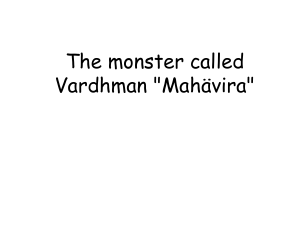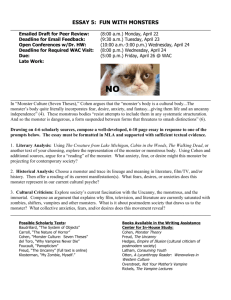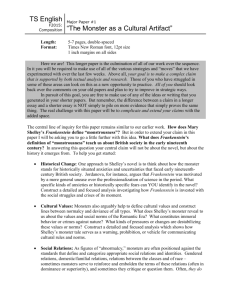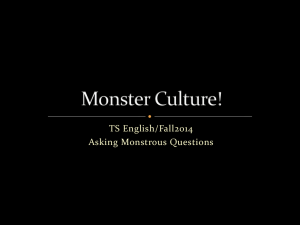Introduction: Reading Monsters in Iberian and
advertisement
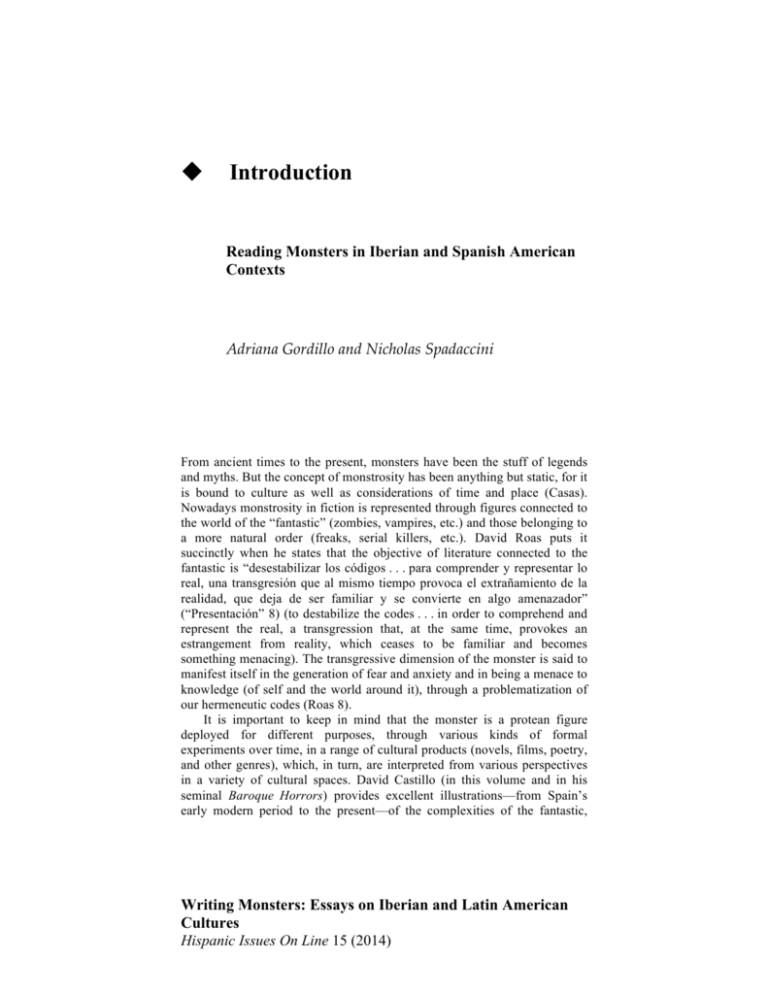
Introduction Reading Monsters in Iberian and Spanish American Contexts Adriana Gordillo and Nicholas Spadaccini From ancient times to the present, monsters have been the stuff of legends and myths. But the concept of monstrosity has been anything but static, for it is bound to culture as well as considerations of time and place (Casas). Nowadays monstrosity in fiction is represented through figures connected to the world of the “fantastic” (zombies, vampires, etc.) and those belonging to a more natural order (freaks, serial killers, etc.). David Roas puts it succinctly when he states that the objective of literature connected to the fantastic is “desestabilizar los códigos . . . para comprender y representar lo real, una transgresión que al mismo tiempo provoca el extrañamiento de la realidad, que deja de ser familiar y se convierte en algo amenazador” (“Presentación” 8) (to destabilize the codes . . . in order to comprehend and represent the real, a transgression that, at the same time, provokes an estrangement from reality, which ceases to be familiar and becomes something menacing). The transgressive dimension of the monster is said to manifest itself in the generation of fear and anxiety and in being a menace to knowledge (of self and the world around it), through a problematization of our hermeneutic codes (Roas 8). It is important to keep in mind that the monster is a protean figure deployed for different purposes, through various kinds of formal experiments over time, in a range of cultural products (novels, films, poetry, and other genres), which, in turn, are interpreted from various perspectives in a variety of cultural spaces. David Castillo (in this volume and in his seminal Baroque Horrors) provides excellent illustrations––from Spain’s early modern period to the present––of the complexities of the fantastic, Writing Monsters: Essays on Iberian and Latin American Cultures Hispanic Issues On Line 15 (2014) GORDILLO AND SPADACCINI ♦ 2 which is “born in the context of the culture of curiosities of the sixteenth and seventeenth centuries, at the meeting place between certainty and doubt, and between apprehension and fascination” (162), and discusses the complementarity of different types of approaches and readings in trying to understand “monsters and their dwelling places” (164). But before we consider some of those transmutations and delve into monster theory to discuss and put into context the specific contributions of the essays in this volume, let us recall that the monster, from the Latin root monere, “to advise,” “to warn,” has often been represented as a deformed, disabled, or hybrid body that includes a wide range of imagery, from pre-Classical mythical creatures, pre-Columbian cosmogonies, and Medieval bestiaries, to freak shows and artificial beings, from golems to cyborgs. As is well known, the etymology of “monster” also ties it to monstrum, which derives from monstrare, that is, “to show,” “to display.” In this sense, the monster becomes a sign, an exhibition that is also an embodiment of the sacred (as Jeremy Biles suggests in his reading of George Bataille). The monster figure could then be viewed as an empty referent that points toward something that is outside its own self; a paradoxical symbol that requires a reader, an interpreter. In the second half of the twentieth century, a discussion of the monster also brought into play a plethora of readings against the grain, which called into question “the idea of time and space as fixed and central absolutes,” something that had already been seen in various arts during the first three decades of that same century with the rejection of “harmony in music, chronological sequence in narrative, and the representation of the visual world in art” (Barry 67). Moreover, the contestation of universalist claims and essentialisms by poststructuralism and deconstruction (and their progenies) were to figure prominently in the generation of monster theories and the way in which they informed interpretations of specific texts, something that can also be seen in the essays included in this volume. In fact, several of them allude to the pioneering work in the area of monster theory by a number of scholars, among them Jeffrey Jerome Cohen, who sees the monster as a symbolic referent, a “mode of cultural discourse” linked to epistemological turns and the construction of identity. Furthermore, the monstrous is said to spring from a “desire to name that which is difficult to apprehend and to domesticate (and therefore disempower) that which threatens” (viii). A look at some of the iterations of the concept of monstrosity across time and cultural spaces allows us to gain insights into how it has been appropriated and productively reinvented over time to deal with cultural, social, political, and philosophical issues. Let us recall that the Classics had seen the world as a complex place that included beauty and ugliness; that their mythology portrayed both of those sides through Olympian models and monstrous titans as well as through furies, giants, sea creatures, and women, HIOL ♦ Hispanic Issues On Line 15 ♦ Spring 2014 3 ♦ INTRODUCTION: READING MONSTERS IN IBERIAN AND SPANISH AMERICAN CONTEXTS who, according to Aristotle, were a deformation of men (Allen 78). Although the classical world usually interpreted the advent of “portents or prodigies” as a sign of misfortune (Eco 107), it was “Cicero’s list of synonyms––monstra, ostenta, portenta, prodigia” that established the meaning of the monster as a symbol called upon to express political and social disasters, something that was to both influence and transcend the Medieval and Renaissance periods (Shildrick 12). Augustinian readings of the Scriptures were to expand symbolic readings of the monstrous, for the need of a deeper understanding of the Bible called for allegorical guidance, thus giving birth to moralizing bestiaries (Eco 114, 125). However, the devastation of the Roman infrastructure throughout the Early Middle Ages coupled with the expansion of wooded areas due to diminishing agricultural practices, also generated a sense of “darkness,” with a geography populated by “uncivilized” others whose languages and cultures became the subject of monstrous representations (Eco 111–13). Such a geography was to expand substantially with the colonization of the “New World” and was to feed the imagination of artists and writers who found new ways of representing the monstrous, often subverting ancient metaphors to refer to a broader scope of social and economic life. Such was also the case with Góngora (to mention but one example) in his baroque inversion of light and darkness, of beauty and monstrosity, to highlight the clash between the agricultural and commercial/economic orders in the Spain of the early 1600s (see Baena in this volume). The nineteenth century was to give birth to a new kind of monster through the horrors born out of the anxiety related to new scientific and technological advances. Their most conspicuous representation is Mary Shelley’s Frankenstein, a story in which the monster incarnates the “fear that the synthetic and mechanistic is destined to eradicate its own creators” (Cohen vii). But that century also saw the literary appropriation of the oral myth of the vampire, a monster that has been said to represent the fear of a cultural and economic other that threatens the capitalist world (Moretti) as well as Victorian sexual heteronormativity (Lethinen). This brief sketch alludes to (and some of the essays in the volume confirm) different readings and interpretations of the monstrous over time, depending on a variety of factors, which include different conceptions of the world and the place of the human in it. In our day scholars have sought to redefine the monster to explore issues of human rights, gender and racial equality, and a range of identitarian issues (see Tumbaga and others in this volume). Many of those studies also take into account the productive work of scholars who have theorized about monsters, about what they represent, and how they can be read from various cultural perspectives. Cohen figures prominently in those discussions, especially his suggestion that cultures can be read based on the monsters HIOL ♦ Hispanic Issues On Line 15 ♦ Spring 2014 GORDILLO AND SPADACCINI ♦ 4 they create (Cohen 3). Within this frame of reference, what he proposes through the reading of monster metaphors is an analysis of a set of symbols that are in constant flux, but whose common thread is their marginality. Their function, Cohen argues, is to challenge us to “reevaluate our cultural assumptions . . . our perception of difference, our tolerance toward its expression. They ask us why we have created them” (20) and, in so doing, the responsibility of the social order is placed on our shoulders; we are asked to challenge ideas dealing with any fixed moral code based on exclusion and difference. Margrit Shildrick’s work is also useful for an understanding of some of the issues discussed in this volume, especially the notion that the relationship between self and other is a vulnerable, non-binary, and noncontainable state that promotes a “constant condition of becoming” (1), a concept extended by William Viestenz in this volume when discussing national identity politics in today’s Spain. Shildrick also rethinks the body as a political place of contestation by questioning “the nature of embodiment itself,” thereby challenging the modern ethos of self-sufficiency and the idea of its existence solely within defined borders that maintain a moral standard, thus placing the monster outside the realm of nature (2; see also Viestenz in this volume). For Shildrick the monster is but another manifestation of nature, “an instance of nature’s startling capacity to produce alien forms within” (10); an idea, one might add, that also played a significant role in the construction of social and legal codes that governed early modern Spain (see Barragán and Martín-Estudillo in this volume). In line with some of the ideas developed by Donna Haraway and Judith Butler, Shildrick argues that the body—the monstrous body—is said to act as a catalyst for the dissolution of boundaries between the other and the self (10). In this same direction, Holly L. Baumgartner and Roger Davis propose the concept of the “host,” a term that is in close proximity to the monster, and which refers to a controlling individual or communal entity that symbolically or literally “opens the door . . . that welcomes the guest or rejects the monstrous or strange” (8), a concept that works in productive dialogue with Viestenz’s idea of neighborliness (in this volume). We can see, then, that there are many possible approaches to the topic at hand and that those approaches can be complementary. But before touching more comprehensively on the essays in this volume, we would also note the work of David Gilmore, which draws from psychoanalytic and anthropological theory (Sigmund Freud, Victor Turner, and Mary Douglas) to examine the construction of the self and the role of monstrous imagery, not as a political arena that embodies all levels of alterity, but as a universal human expression of primordial fears. The fragmented body of the monster is said to be “made up of pieces of a reassembled reality” that, according to Freud, constitutes a set of displaced emotions that are at the core of the creative process, making the monster a contradictory entity that incarnates HIOL ♦ Hispanic Issues On Line 15 ♦ Spring 2014 5 ♦ INTRODUCTION: READING MONSTERS IN IBERIAN AND SPANISH AMERICAN CONTEXTS fear, repression, and a growing impulse that is “indispensable in dealing with the challenges of life” (189, 190), an idea that can also be examined along political lines to unmask the controlling and repressive aspects of dictators and dictatorial regimes (see Megan Corbin and Carlos Vargas Salgado in this volume). For Gilmore, the hybrid nature of the monster is also a representation of human consciousness and its animalistic self, a struggle between traits that we admire from our biological nature and the violent instincts that we tend to reject. Rather than dealing with this internal duality, Gilmore argues that our minds deify “the good within us and [create] a monster of the bad,” a mental exercise (an “interchangeability of human and monster,” as the author maintains) that explains “why most monsters retain human characteristics and the worst of human traits” as a way of coping with these opposing states (192–93). Gilmore’s rendering of the monster symbolism could also be seen in dialogue with some of the ideas proposed in a number of the essays in this volume, particularly in Bradley Nelson’s analysis and discussion of the ambivalent uses of religion in the representation of violence against women in María de Zayas’ Desengaños amorosos. Nelson’s notion of “interchangeability” is also a useful concept in Julio Quintero’s discussion (in this volume) about the figure of the dictator and the appropriation of popular mythology in the construction of political, gender, and racial identities. The contributors to Writing Monsters: Essays on Iberian and Latin American Cultures explore a number of issues, including (but not restricted to) those tied to the limits of what it means to be human (from early modernity to contemporary times), a notion with sociocultural, economic, and geopolitical implications that plays an especially dominant role in today’s globalized world. The versatility of the metaphor and its uses is also apparent in the writing and receptions of texts of the early modern and colonial periods, as the metaphor of the monster is used to not only justify but also to contest gender violence. Such versatility is even more apparent today as the monster is both a referent for dictatorial figures and an incarnation of more abstract ideas that encompass both the consequences of authoritarian regimes and (more importantly) the creation of counterdiscourses that “occupy” the language of those in power. These essays are enriched by the theoretical readings mentioned in this introduction as well as by other key texts of literary/cultural theory and criticism, which engage them in productive dialogue in their respective analyses of novels, films, poems, and other materials dealing in one way or other with the notion of monstrosity and its uses. In so doing, they take into account the specificity of both the literary, sociocultural, and (in some cases) the political contexts of the works in question and their all-important loci of enunciation. Thus José P. Barragán and Luis Martín-Estudillo draw from David Castillo’s Baroque Horrors and a rereading of Michel Foucault by Italian philosopher Roberto Esposito regarding biopolitical European HIOL ♦ Hispanic Issues On Line 15 ♦ Spring 2014 GORDILLO AND SPADACCINI ♦ 6 ideologies to discuss the representation of monstrous births in sixteenth- and seventeenth-century Spain in light of the political turmoil of the time. They argue that discourses on monstrosity in relation to human gestation and birth emerged from “the margins of humanity and its communitarian organization” (13), while the medical and popular representations of monstrous births are placed at the core of authoritative discourses on “the limits of humanity” (20). The authors make productive use of Esposito’s concept of immunity to explain how the monster’s life became a sign of how authorities dealt with life itself. Thus, the destruction or killing of the monster baby turned the community into the very monster that it rejected and feared. For the monster was, after all, part of nature, and, as such, was tied to the boundaries of what it meant to be human. For that reason no individual could ascribe to him- or herself the power to obliterate the monster, a power that was reserved to God and, in the specific case in question, to the Christian State. Julio Baena offers a nuanced reading of Góngora’s Fábula de Polifemo y Galatea, to show that, within the economy of the poem, the beautiful Galatea is the “monster” whose values and actions turn their back on the agricultural world of the Cyclops Polyphemus in favor of a monetary economy that privileges navigation and commerce. In Baena’s reading, Galatea is “an exorcist, a monster of monsters. Far more horrifying and powerful than Polyphemus” (36), making Góngora’s retelling of the myth a “mythoanalysis,” a concept used by Baena to discuss the “refocusing of ancient mythemes in light of new threats and new taboos” (36). Baena’s reading of the poem shows how canonical texts can be reread productively through close analysis, scrupulous attention to scholarship (of both Góngorá’s contemporaries and modern editors and critics, including the towering figure of Dámaso Alonso), and productive use of theory, not only monster theory, as envisioned by Cohen, but also Deleuze and Guattari’s Anti-Oedipus and their Mille plateaux (A Thousand Plateaus), whose influence is reflected in Baena’s observation that “the sea, that primordial ‘smooth space,’ was, after all, the first to be mapped, charted, striated by mercantilism” (36). Bradley Nelson undertakes a reading of María de Zayas’s Desengaños amorosos (with special focus on the novella El Verdugo de su esposa) to suggest that it might have been “fashioned as a truly monstrous sign” (56). Reading Zayas’s work against a contemporary filmic text (Quentin Tarantino’s Pulp Fiction) “that refuses historical and ideological closure” (44), Nelson points to a narrative that allows us to see the ambiguity of religious discourses and the uses of the same to justify violence against women. Focusing on the “philosophical deadlocks and ironies in Desengaños” (45) he offers two possible readings: one in which Christian doctrine supports the idea of a permissive God that allows the perpetration of violence against women; the other in which we are made to witness the emergence of an “‘animist’ aristocratic culture [that] has transformed HIOL ♦ Hispanic Issues On Line 15 ♦ Spring 2014 7 ♦ INTRODUCTION: READING MONSTERS IN IBERIAN AND SPANISH AMERICAN CONTEXTS theological doctrine into an abecedario of tropes and maxims for justifying sexual and other kinds of violence” (47). Nelson’s reading of Zayas’s oeuvre explores how Divine Providence has become a parody that serves as a sign of a monstrous rhetoric to justify men’s abuses against women. This suggestive reading of the text, grounded in a deep knowledge of literary, cultural, social, and political issues related to Spain’s early modern period (see his recent book The Persistence of Presence), also takes into account the productive feminist criticism devoted to Zayas in recent times, without arriving at the same conclusions. On this subject he concurs with David Castillo’s observations in Baroque Horrors, namely, that Zayas’s critique of the nobility and men’s propensity for excess and fascination with novelty and violence in fiction responds to a different logic, which is “the logic not of a postmodern liberalism, focused as it is upon issues of gender equality, but of seigniorial organicism, of eminently feudal extraction, based on a hierarchy of ‘blood’ and ‘lineage’” (171). Bonnie L. Gasior focuses on how women writers of early modernity interrogate their social conditions through creative texts. Relying on a close reading of two poems by Sor Juana Inés de la Cruz––“Romance que un caballero recién venido a la Nueva España escribió a la Madre Juana” and “Romance que respondió nuestra poetisa al caballero”––she argues that each of them shows both conformity and rebellion and, in so doing, connects the triad “gender, monstrosity, and women’s writing” (62). Gasior discusses the association of gender crossing with the monstrous, which, in turn, is connected to a sort of “social anxiety” engendered by the new role of female writers in Sor Juana’s time. For Gasior, Sor Juana’s dialogic and male voices in the poems are strategies deployed by the author “to be understood as an agent of influence and authority and, conversely, to be misconstrued as one of danger and anxiety” (64). José Antonio Giménez Micó examines Caliban as a symbol of “radical alterity” to discuss Latin American hybrid identity and its postcolonial resignification. Grounding his reading in postcolonial theory, he analyzes Aimé Cesáire’s A Tempest through the lenses of Homi Bhabha’s idea of “emphatic mimicry” to show that the monstrous or the hybrid may be viewed with pride, for it challenges the dominant language by transforming it into a new way of expression, thus breaking with the notion of language as an inescapable prison of the colonized. For Giménez Mico, Césaire’s A Tempest “occupies” the Western episteme thanks to Caliban’s monstrosity and how the power of enunciation is used as a strategy of defiance and resistance. It is this monstrosity, this hybridity, along with parody, that allows Cesáire to write from the language of the colonizer in order to subvert it. In this view, the monster is called to expose the contradictions of Western expansion: “how to subjugate entire nations while promoting a humanist teleology based upon universal emancipation” (83). HIOL ♦ Hispanic Issues On Line 15 ♦ Spring 2014 GORDILLO AND SPADACCINI ♦ 8 Through the analysis of Roberto Bolaño’s Estrella distante, Carlos Vargas Salgado explores the role of memory in the construction of monstrous characters (as incarnations of evil), both within the context of a dictatorship and within a literary tradition that duels in these symbolic images. According to Vargas Salgado, Bolaño’s monster comes to existence as “a result of certain historical conditions and mechanisms of political power,” in the Chile of the 1970s (100). His reading of the text, which involves a reconstruction of the events that lead Tagle/Wieder to become a monster, also discusses the role of literature in the cultural and political arena and how it can serve as a catalyst to both shape and question images of historical events. For Vargas Salgado, Estrella distante allows one to enter into a discussion of an aesthetics of evil, its origins, function, and reception. One might also add that the monstrous, fascist bard in the novel is thought to be a caricature of the avanzada poet Raúl Zurita, a well-known antidictatorship voice who, with many other artists and intellectuals, remained in Chile during the years of dictatorship and repression in contrast to others, such as Bolaño, who lived in exile (Kaup 136). Julio Quintero explores the idea of monstrosity through a discussion of Oficio de difuntos (1976), a novel by Arturo Uslar Pietri. The essay focuses on the representation of Juan Vicente Gómez as a complex figure in Venezuelan history whose reputation oscillates between that of a villain and that of a saint, thus situating him in what Cohen would call “a metaphoric crossroad.” Quintero also discusses the fetishization (monsterization) of the Andean region, a space where ideas of progress and atavism converge, becoming the perfect scenario for discourses about race and miscegenation within the context of national narratives. In this regard, Quintero’s discussion of monstrosity draws an interesting comparison between Uslar Pietri’s representation of the Venezuelan dictator and the vampire myth, a kind of geopolitical symbolism for the expansion of the capitalist enterprise in the nineteenth century, a symbolism that also functions as a gender and racial destabilizer. Finally, by connecting this idea with the emergence of the María Lionza myth, a Venezuelan legend that is at the intersection of the country’s political and religious imagery representing the syncretism of European/Christian and indigenous beliefs, the essay brings to mind how this type of discussion is still relevant today, as politicians continue to invoke supernatural images and well-known myths for propagandistic, political purposes. In a similar direction, Ariel Zatarain Tumbaga discusses the idea of monstrosity in conjunction with notions of race and gender as power structures that deal with identity politics in Mexico during the first half of the twentieth century. His analysis of Rosario Castellanos’s Balún Canán examines the figure of the Dzulum, “a venerated supernatural presence of indigenous origins” that is at the core of the sociopolitical uproar generated by Lázaro Cárdenas’s agrarian reforms and the consequences of the HIOL ♦ Hispanic Issues On Line 15 ♦ Spring 2014 9 ♦ INTRODUCTION: READING MONSTERS IN IBERIAN AND SPANISH AMERICAN CONTEXTS “indigenismo politics” of the time (141). The author presents the Dzulum as a symbol of alterity that embodies not only the rebellious indigenous component of rural Mexico, but also a social anxiety by disgruntled rural women who challenged the masculine power structure in early twentiethcentury Mexico. Following some of the ideas developed in the previously-mentioned Baroque Horrors, David Castillo traces a genealogy of the monster in Spain’s early modernity and its direct successors, Victorian gothic narratives, which serve as a platform for the exploration of today’s depictions of the vampire and the zombie, both in cinematic and literary form. For Castillo, the cultural explosion surrounding vampires and zombies shows how the symbolism of these monsters has been updated in order to express postcolonial concerns related to global market forces and contemporary issues linked new types of slavery, as well as the dehumanization and objectification that lies behind mass production and consumerism. Needless to say, the mass production of monsters is, in and of itself, a sign of the same problem that they were meant to warn us about (an idea that is also advanced by Baena in this volume): how can we write about monsters while using the language and social structure that they themselves are trying to defeat? William Viestenz’s analysis of La pell freda (Cold Skin), a novel by Catalan writer Albert Sánchez Piñol, examines the idea of the neighbor as someone who is both an enemy and a friend, a Manichean notion that also relates to what it means to be human. Viestenz deploys philosophical ideas about animalization and humanization, which involve a discussion of self and other as a means to construct the concept of neighborliness and its ethical implications. The neighbor, says Viestenz, “has embedded within both monstrosity and altruistic ethical behavior,” a characteristic that rejects the idea of fixity and suggests that, like the monster, our ideas of friendship and enmity are in flux, constantly reshaping the limits of humanity, and therefore, those of our political agency (188). The humanization of the monster and the animalization of the human in La pell freda are also a set of symbols that question the limits of political identities, particularly, of “peripheral nationalisms within the logic of the Spanish state” (195). Viestenz also highlights the novel’s call for an awareness of the fluid character of the concept of neighborliness in a political context, an awareness that might serve to prevent “regress[ion] into monstrosity” (196). Finally, Megan Corbin discusses the social role of madness as a boundary that determines the limits of normality and abnormality, of citizen and non-citizen, of self and other. Through an analysis of Eliseo Subiela’s film Hombre mirando al sudeste, Corbin explores the portrayal of a madman as an alien to be removed from Argentinean society, thus constructing an allegory “of the ongoing threat posed by the political dissident” (203). She notes that while the madman is identified with the monster and the irrational, HIOL ♦ Hispanic Issues On Line 15 ♦ Spring 2014 GORDILLO AND SPADACCINI ♦ 10 the film shows that most rational ideas come from the madman, and that those ideas demand a reflection on the repressive and exclusionary practices that call into question the nature of the monster, thus blurring the boundaries of reason and questioning the politics of mental health as a measure of difference and segregation. As seen in the essays included in this volume, the monster has been a persistent symbolic referent within the Hispanic world, and its presence––on both sides of the Atlantic over time––has acted like a foundational narrative that brings to account totalizing conceptions of self and of social and economic orders, thus becoming an expression of their limits. The monster speaks to and from a marginal space, which denies (and confirms) the unfeasibility of a social order based on absolute hierarchical power, whether one speaks of politics, religion, gender, class, and/or race. In a Hispanic world marked by hybridity—a space of convergence of a multitude of cultures that exceeds and challenges the logic of the modern ethos, while also reaffirming it––the monster becomes a double referent, one that defies both the limits of its surroundings and those of its own self. In this sense, it generates a cyclical symbolic motion, which challenges both the locus and the language from which the monster is created. Works Cited Allen, Prudence. The Concept of Woman. Volume II, Part 1. Grand Rapids, MI: Eerdmans, 2002. Print. Barry, Peter. Beginning Theory: An Introduction to Literary and Cultural Theory. Manchester: Manchester University Press, 1995. Print. Baumgartner, Holly L., and Roger Davis. Hosting the Monster. Amsterdam: Rodopi, 2008. Print. Biles, Jeremy. Ecce Monstrum: Georges Bataille and the Sacrifice of Form. New York: Fordham University Press, 2007. Print. Casas, Ana, ed. “Prólogo.” Las mil caras del monstruo. Barcelona: Bracket Cultura, 2012. Print. Castillo, David. Baroque Horrors: Roots of the Fantastic in the Age of Curiosities. Ann Arbor: University of Michigan Press, 2010. Print. Cohen, Jeffrey Jerome, ed. Monster Theory. Minneapolis: University of Minnesota Press, 1996. Print. Eco, Umberto, and María Pons Irazazábal. Historia de la Fealdad. Barcelona: Lumen, 2007. Print. Gilmore, David D. Monsters: Evil Beings, Mythical Beasts, and All Manner of Imaginary Terrors. Philadelphia: University of Pennsylvania Press, 2003. Print. Kaup, Monica. Neobaroque in the Americas. Charlottesville: University of Virginia Press, 2012. Print. Lethinen, Katri. “Twenieth-Century Vampire Literature: Intimations of Evil and Power.” This Thing of Darkness: Perspectives on Evil and Human Wickedness. Amsterdam: Rodopi, 2004. 1–19. Print. HIOL ♦ Hispanic Issues On Line 15 ♦ Spring 2014 11 ♦ INTRODUCTION: READING MONSTERS IN IBERIAN AND SPANISH AMERICAN CONTEXTS Moretti, Franco. Signs Taken as Wonders: Essays on the Sociology of Literary Forms. Trans. Susan Fischer, David Forgacs, and David Miller. London: NLB, 1983. Print. Nelson, Bradley J. The Persistence of Presence: Emblem and Ritual in Baroque Spain. Toronto: University of Toronto Press, 2010. Print. Roas, David. “Presentación.” Pasavento: Revista de Estudios Hispánicos 1 (2013): 7–10. Web. Shildrick, Margrit. Embodying the Monster: Encounters with the Vulnerable Self. London: Sage, 2002. Print. Gordillo, Adriana and Nicholas Spadaccini. “Introduction: Reading Monsters in Iberian and Spanish American Contexts.” Writing Monsters: Essays on Iberian and Latin American Cultures. Eds. Adriana Gordillo and Nicholas Spadaccini. Hispanic Issues On Line 15 (Spring 2014): 1–11. Web. HIOL ♦ Hispanic Issues On Line 15 ♦ Spring 2014

